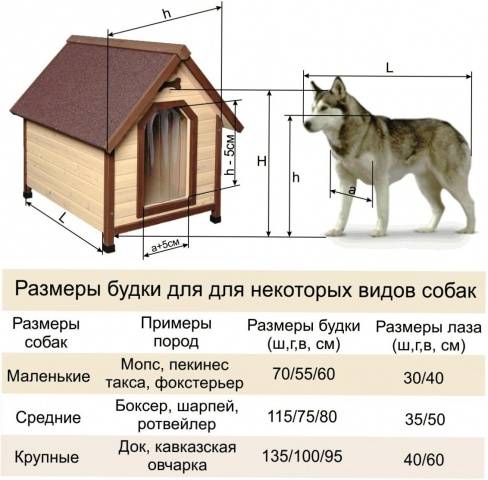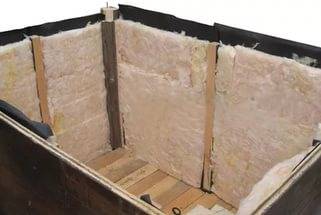Content
Building a doghouse is not difficult. Most often, the owner knocks a box out of a board, cuts a hole, and the kennel is ready. In the summer, of course, such a house will suit a four-legged friend, but in winter it will be cold. Today we will look at how to make a warm dog house, inside which the animal will not freeze even in severe frosts.
Calculation of dog kennel dimensions
The photo shows an example of the dimensions of the booth and manhole for different breeds of dogs. When making a dog kennel, you can use the dimensions from the table, or perform your own calculations.
The height of the kennel is determined by the height of the dog at the withers, and an additional 15 cm is added. The reserve is needed for winter bedding, and suddenly the animal will grow up. The depth of the booth is equal to the length of a lying dog with its paws extended in front of it. The measurement is taken between the tips of the paws and tail, and 15 cm is added to the result.
Calculation of the width of the house depends on its design.If the booth consists of one compartment, then its width is calculated according to the same principle as its depth. The dog should be comfortable lying even across the kennel. In northern regions with long, harsh winters, it is wise to build a house with two compartments. The sleeping place is arranged in the second compartment from the manhole. This is where the dog will sleep in the winter. The dimensions of the sleeping compartment are calculated using the examples already given for determining the width and depth of the booth. The vestibule is made in front of the sleeping compartment. Its size is selected arbitrarily according to the dog’s build. The animal must enter and exit the house freely.
It is important for the dog to properly organize the opening in the kennel. It is cut out into a rectangular or oval shape, calculating the height of the animal’s withers, adding 10 cm. The width of the hole is made 8 cm greater than the width of the dog’s chest.
Making a drawing of a winter booth with a vestibule
The design of the dog house is simple, and it is unlikely that you will need to draw up drawings for it. Just for reference, in the photo of the presented diagram you can see an example of a kennel with two compartments and a folding roof.
If you still decide to build a dog house according to the drawing, this is considered only a plus. The diagram will help you more accurately determine the dimensions and shape of the house.
A few useful tips will help you develop a drawing correctly:
- The internal space of the kennel should be enough for the dog to freely unfold and sleep comfortably. We must remember that a young puppy will grow up over time and will need more space.
- To build a warm kennel, it is better to take only boards.Wood retains heat well, is easy to process, and is also harmless to the dog.
- In the northern regions, preference should still be given to a booth with two compartments. During design, structures are provided with double walls, between which space is left for laying insulation.
- Alternatively, a warm dog house can be built inside the enclosure. Owners who have acquired a large dog who is not put on a chain resort to such solutions.
- At the development stage, the drawing for the booth is determined by the shape of the roof. For a large dog kennel, it is better to make a lean-to opening roof. In the summer the dog will lie on it. A gable roof increases the space of the kennel, so it is preferable to build it on a small house.
By drawing up a drawing taking into account all the nuances, you will be able to provide for all the little things, and an insulated dog house will become a comfortable home.
The process of making a wooden booth
So, with the preparatory questions sorted out, it’s time to start making a dog house:
- Making any dog house with your own hands begins with assembling the frame. For these purposes, you will need a beam with a cross section of 50x50 mm. You can take blanks that are 10 mm thicker or thinner. Nothing will change significantly from this. From pieces cut to size, the frame of the bottom of the dog kennel is assembled. You should get a rectangular frame. For a large dog, it is better to strengthen the frame with additional jumpers so that the bottom does not sag. The finished frame is sheathed on top with a board 30 mm thick.
- The floor of the dog kennel is ready, let's move on to the walls.Vertical posts are attached from similar timber from the corners of the bottom. Two additional elements are placed on the front wall for the manhole. If the doghouse is designed for two compartments, then inside there will be a partition with another hole. For this you will have to install two more racks. At the top, the racks are connected to each other by a beam. The resulting frame will be the base of the kennel roof.
- The finished frame is sheathed with boards or wooden clapboards, and the bars must remain inside the house. They will still be needed when the walls are covered with insulation. At this stage, an internal partition is nailed from the board, and a hole is immediately cut out on two walls using a jigsaw.
- The roof structure of a warm house differs from the usual cold structure. Even in the case of a gable option, you will have to sacrifice internal space by installing a ceiling inside the kennel. So, a piece of plywood is attached to the top trim of the frame posts, just from under the bottom of the frame. This will be the ceiling. On top of the plywood there was a recess, edged with a beam of the top trim. Roofing felt is laid here, then foam plastic or mineral wool, again roofing felt, and another sheet of plywood is nailed to the frame on top. The result was a warm layered ceiling located between the frame bars of the upper frame of the racks.
- There is no point in making a gable roof for an insulated dog kennel, since the internal space will not increase anyway due to the ceiling. To build a pitched roof, rafters made of boards are fixed to the upper frame, forming a slope towards the rear wall. A board is nailed to the rafters on top, on which the roofing material is laid.
- The resulting gaps between the roof and the body of the house are covered with platbands. To prevent heat from escaping from the doghouse, the opening is covered with a tarpaulin or rubber curtain.To make it heavier, you can attach a weight at the bottom.
But it’s too early to attach the curtain and the roof, because the process of insulating the walls still awaits. And we'll do this right now.
Insulating a doghouse
The question of how to insulate a dog house should not be a problem, since any thermal insulation material will do. Typically, mineral wool or pieces of foam are used.
So let's get started:
- The insulation of a dog house must be taken seriously, and first of all, raise it off the ground. The kennel is turned upside down. The bottom boards were nailed from the inside, so a timber frame remained on the outside. A layer of roofing material is placed inside the frame. Insulation is placed on top of it, and then roofing felt again. Now this entire layer is covered with a board. To raise the insulated bottom from the ground to the bottom frame, legs are nailed from pieces of timber with a cross-section of 100x100 mm. They can be made about 100 mm high.
- A dog house with an insulated bottom is placed on its legs, after which they begin to work on the walls. In the photo you can see that the insulation is attached to the inside of the walls. After sheathing the frame with boards, there were bars inside the dog kennel that formed cells. This is where they put the insulation in the same way as they did on the bottom. The interior lining can be made of plywood or OSB.
Now you can close the hole with a curtain, put on a roof and paint the booth with soft oil paint or open it with varnish.
Electric heated dog house
Of course, insulating a dog house for the winter is good. However, this may not always be enough. To heat the dog’s home when the temperature outside drops below -30OC, electric heaters will be required.
Electric panels for heating the booth
Panel heaters are well suited for heating a dog house.The maximum heating temperature of the device is 50OC. The dog will not get burned on the walls of the panel, so it does not need to be covered with a wooden lattice. The thickness of the heater is about 20 mm. The panels are produced in two sizes: 590x590 mm and 520x960 mm. The heaters operate silently.
Infrared film
You can get an excellent heated booth if you put infrared film in the walls under the inner lining. It is usually used when installing electric heated floors. With the onset of severe frosts, it is enough to supply electricity to the film heater, and it will heat the walls of the booth to 60OC. The dog will be comfortable in any frost, and electricity consumption will be minimal.
DIY heater
If a modern heated booth is not affordable for you, an alternative option is offered. A piece of asbestos cement pipe is cut along the length of the dog house. A lampshade is cut out of a tin can. The size of the jar is selected so that it fits freely inside the pipe. A tin lampshade is attached to a socket with a 40 W light bulb. The finished heater is inserted inside the pipe, the wire is taken out of the booth, and connected to the network through the machine. The entire structure and cable must be protected so that the dog does not chew them.
The video talks about making a homemade heater for a dog:
Conclusion
So, the insulated dog house is completed. Now all that remains is to install it in its place, arrange the area and let the dog run.















